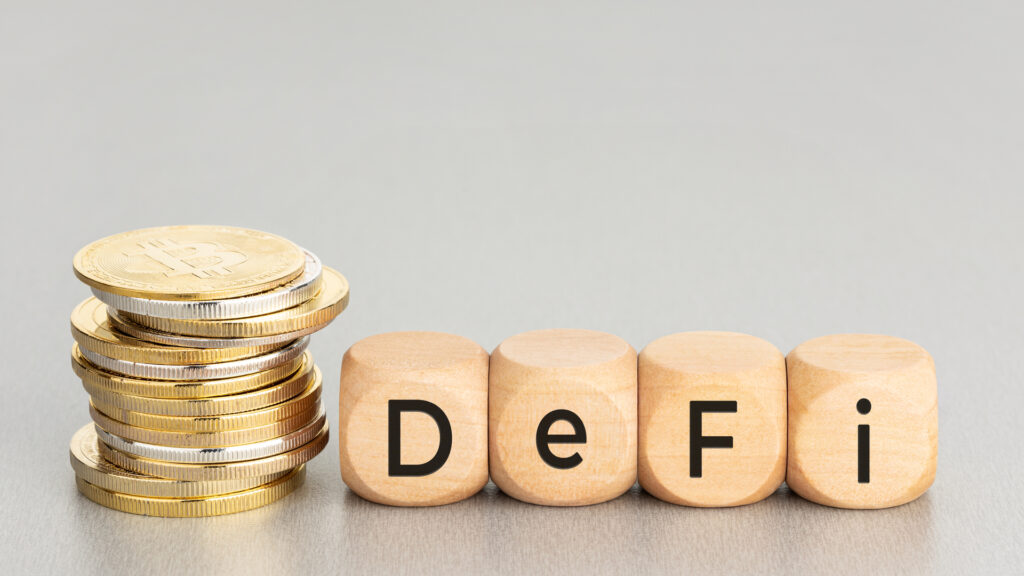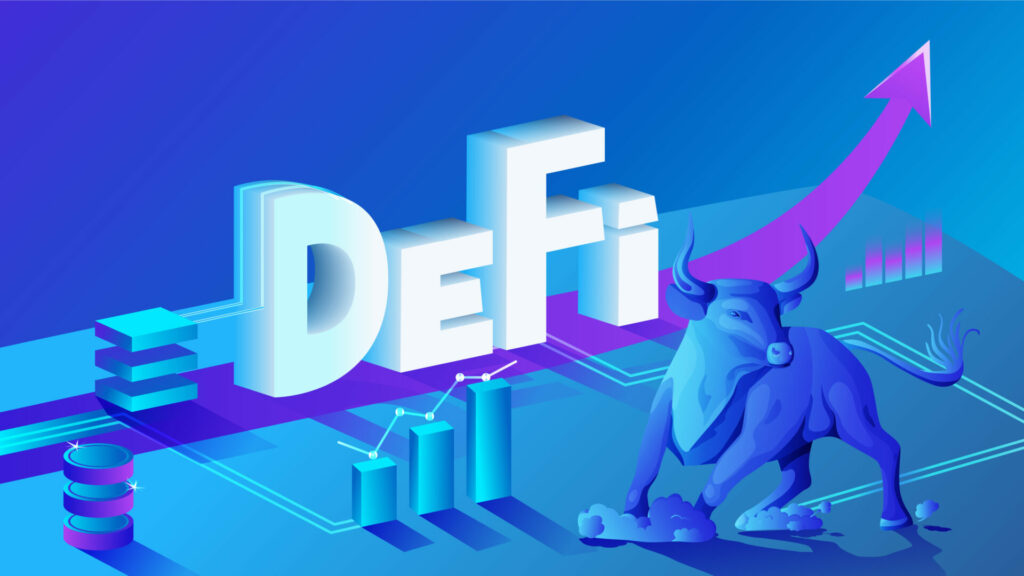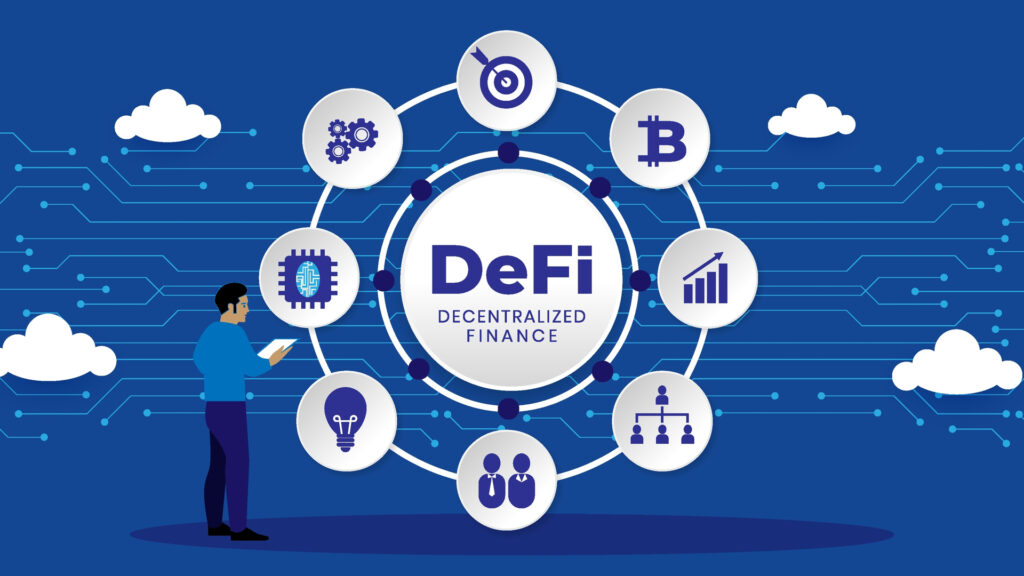Over the past few years, decentralized finance, or DeFi, has become a viable alternative to the traditional financial system. As a result, its combined value will amount to more than $250 billion in 2022! Although, despite its popularity and dominance in today's market, DeFi is still a mysterious and complex phenomenon for most investors and cryptocurrency fans. This article will find out what DeFi is about, how to work with it, and why we need it.
What is DeFi in crypto?
DeFi represents blockchain-based financial services and applications designed to make working with cryptocurrencies easier, faster, and effortless. DeFi means that you can minimise the involvement of banks and other intermediaries in managing budgets, transferring funds, and using financial products, therefore being independent of various institutions and maintaining transparency across all working practices. For example, although the traditional financial system revolves around institutions like the Central Bank, payment systems like Visa and Mastercard, and a reserve fund, there are no big players in the DeFi space – everyone is equal.
In practical terms, decentralized finance has the following advantages:
- It is commission-free because neither banks nor financial companies participate in the financial process and therefore do not take a percentage of the transactions.
- Higher security is provided by a digital wallet protected by security protocols. Unlike a debit card or a safe deposit box in a bank, it is almost impossible to gain unauthorized access to a wallet.
- It is convenient and fast. All you need is access to the Internet to use DeFi. No permits, documents, or other interactions with the recipient or authorities are necessary. The transfer of funds, including international, can take place during the day and at night and takes just a few seconds.
How does DeFi work?

To work with decentralized finance, you'll need special software called the DeFi app (decentralized application). Most of these apps use the Ethereum blockchain. To become a user, you do not need to submit a request or set up an account –connect to the Internet, register, and get an account. Following that, numerous ways to apply DeFi in real life become available to you, including in the following areas:
- Lending. You can lend your cryptocurrency just like you would lend money to your friends. Although you do not have to stick to a strict time limit, it could be every minute. Interest is calculated immediately, in real-time. Likewise, you can get short-term loans without filling out documents or visiting financial institutions.
- Trading. With DeFi, you can easily generate peer-to-peer trades, including buying or selling various assets and DeFi stocks, without resorting to brokerage services.
- Savings. DeFi offers higher interest rates than any other bank. This way, you can protect your savings from inflation and increase your income.
- Buying products. You can use them as futures contracts or stock options by wagering on different assets.
DeFi technologies and protocols
Decentralized finance is a complex system in terms of structure and design. However, this complexity is designed to protect all practices from external interference, attacks, and software risks and to ensure the uninterrupted, decentralized, and secure transfer of payment and smart contracts.
That is why any decentralized finance project is based on five distinct levels:
- The level of calculations.
As a general rule, this is the underlying Ethereum blockchain, and it is used to write the code and design the services. It is also responsible for launching the system, so DeFi is unthinkable without it. - Protocol level.
This level is responsible for recording, saving codes, and managing tasks and actions within applications. In simple terms, the DeFi protocols level transforms the entire system into a practical tool, making it work. - Asset level.
Cryptographic tokens, an alternative to fiat money, are also produced by the protocol level. Bitcoin, Ethereum, Dogecoin, and other currencies can all be discovered here. - Application level.
This is made up of decentralized applications (DeFi apps or dApps). Unlike the second level, run exclusively by developers, it is accessible to ordinary users, presenting a clear and simple interface. It is essentially an "external appearance" of DeFi – the program that can be downloaded on a PC and a smartphone to use all the features of the other levels. - Aggregation level.
At this level, users are provided with a set of those four financial services that emerged due to the integration of the new DeFi platform. For example, a simultaneous lending and borrowing service increases the transaction speed.
What is a DeFi token?

DeFi tokens comprise several cryptocurrencies utilised on decentralized platforms applying their functions and offers. They operate based on smart contracts. DeFi tokens are licenses for users to access certain application services or an entire organization, which are also built on a blockchain. An example would be DeFi Yield or DeFi Coins.
In April 2022, the market capitalization of DeFi tokens was about $220 billion, a relatively small share of the entire cryptocurrency market, which is $1.7 trillion. However, DeFi tokens are one of the fastest growing sectors in the blockchain world, with a value of about $110 billion. In fact, during this time, it has doubled!
DeFi solutions
There are millions of DeFi solutions and startups for providing loans and financial assistance to small, medium, and large businesses. With their help, you can significantly simplify many bureaucratic procedures, increase the finance department's productivity, and ensure the security of all funds. According to the findings of the research center StartUs, the top five FinTech projects include:
- DigiliraPAY, a Turkish startup with its own decentralized payment gateway based on blockchain and DeFi technologies. Thanks to their application, a business can receive and likewise make various payments in cryptocurrencies and withdraw them into fiat. All this is achieved without paying fees and with insurance through smart contracts.
- DeFiner is an American company providing a DeFi lending practice. Businesses and ordinary users can lend any cryptocurrency without restrictions, earning interest. They can also borrow against a deposit. Since the startup is based on Ethereum, all net profits are distributed among DeFi token holders.
- Mt Pelerin is a startup from Switzerland offering asset tokenization for individuals and organizations that invest in tangible assets and want to transfer them into the digital space. Tokenisation enables you to "back up" any assets with blockchain technology, protect them, and trade them. These may be securities and real estate or even antiques.
- TrustWorks is a UK startup with a charitable purpose. It helps those in need by providing them with low-cost decentralized finance services. The project also uses stablecoins and self-storage, which can be integrated into various smartphone wallets and apps.
- GoldFinX is a Singapore-based startup offering microfinance and microloans to small gold mines. In addition, the company provides its DeFi coin, GiX, which is traded on both centralized finance and cryptocurrency exchanges.
What is DeFi 100?

DeFi 100 (or D100) is a synthetic index fund development and a Binance Smart Chain (BSC) project representing a cryptocurrency managed through daily rebasing. Initially, this token was designed to reflect the DeFi market's capitalization and become an investment tool. Still, the token is also available to traders as an asset for savings or trading.
According to a statement from DeFi100 management, it is the first rebase project based on the Binance blockchain. Its development group is called Wrapp3d. However, its members stay anonymous. The rebasing process occurs when the DeFi100 spot price exceeds or falls short of its target value. In the first case, the supply of tokens increases, decreasing the spot price. In the second case, the supply of tokens drops, and the spot price increases. However, as of September 2022, the value of DeFi100 on the Coinbase exchange is $0.01.
How to buy DeFi
Most DeFi tokens can only be purchased for other cryptocurrencies and exclusively on decentralized exchanges. However, major DeFi tokens are also obtainable on centralized platforms such as Coinbase or Binance. They are available for buying, selling, or investing like any other crypto.
To buy decentralized finance tokens, you must open a wallet on one of the exchanges and then purchase whichever cryptocurrency is the most useful for you in terms of using it to buy tokens. Subsequently, DeFi tokens are purchased similarly to any other coins – through a special exchange section with a receipt to your new wallet. In addition, this wallet is responsible for storing tokens, which you can later dispose of in any way you like. In a nutshell, everything is simple and even primitive.
What is a DeFi wallet?
The DeFi crypto wallet is unrelated to other wallets offered by centralized exchanges where you can store your regular crypto assets. Whereas in the case of a Coinbase Wallet, you are sacrificing asset control, as you would with a bank, in DeFi-only wallets, nobody will be able to access your tokens. The wallet is protected by a private key or initial phrase (similar to a password). You will lose access to your DeFi savings if you forget them. However, it is accurate to say that the key is impossible to forge or steal. Likewise, governments will not be able to hack or freeze your assets – which will only be possible through a request to the issuer.
Two kinds of wallets are not associated with storage – software wallets and hardware wallets. The first is a familiar (usually free) online storage, which can be accessed through a website or app. For example, those wallets include WalletConnect or MetaMask. The second type of wallet, hardware wallets, has been developed by companies such as Ledger. They have physical flash drives that you can buy to store your assets offline (this method is also called "cold storage").
You can discover more about these wallets by entering "crypto.com DeFi wallet" into any search engine. There you will also find many educational articles and even courses dedicated to this, which can also be found in the public domain or on YouTube if you are a beginner.
How to invest in DeFi

The main thing that makes DeFi particularly attractive to investors is DeFi liquidity mining and liquidity pools. In this repository, all assets of market participants are collected. This ensures maximum liquidity for those wanting to make a DeFi exchange soon. It is the equivalent of "printing" money in banks for many savers. Only the pools have been blocked by a smart contract and used for trading.
There are several ways to invest in DeFi which are suitable for both professionals and beginners:
- Buying assets.
The most obvious and most straightforward way, which we discussed earlier. It is as simple as possible: buy low and sell at a higher price. Of course, making profits this way is challenging. However, it can be an excellent financial strategy for long-term goals. - DeFi staking.
Staking or rates. DeFi represents the locking of assets by entering into smart contracts and receiving rewards if certain conditions are met. Simultaneously, dividends are usually paid in frozen tokens, and the interest is either fixed, variable, or annual. This method is appropriate for creating a source of passive income and virtually has no risks. However, the high rates might be an illusion. So, it is worth focusing on the result. - DeFi farming.
This is basically "token farming," just as in agriculture. In practice, however, it is a more sophisticated version of staking. Farming aims to generate DeFi on different farms instead of putting everything into one asset. So, for example, you perform certain actions for DeFi, obtain a token for another action in return, wager it and receive a new token. And in doing so, you place bets and earn. - Lending.
It is a way to diversify your investment portfolio if you have multiple DeFi assets. So, you could lend your assets to other people against collateral or interest and exchange them for certain other assets. DeFi algorithms usually determine the percentage by calculating the loan average as well as supply and demand. So, the greater the demand for credit, the more money you make. - DeFi games.
This is probably the most unusual way to become an investor! You download an MMORPG game to your phone or computer and purchase a few tokens set by the game to start playing. Then you complete various tasks in alliance with other players or build your own city and simultaneously earn new tokens. In the game, you can even purchase NFT collectibles in this way, such as weapons for a character or buildings. The most popular representatives of this game and a way of earning money are DeFi Kingdoms and My DeFi Pet.
How to track DeFi prices and demand
You do not have to do this manually. Instead of monitoring various exchanges simultaneously, you can turn to special services. For example, the DeFi Pulse Index is a tool for tracking the performance of tokens across the decentralized industry. This index is calculated based on changes in offers and the cost of each individual token. There are other similar DeFi projects. For example, DeFi llama is extremely popular.
DeFi regulations
As I mentioned, decentralized finance is growing exponentially, bringing more innovative projects, startups, and stakeholders to the industry. However, the very nature of DeFi, which is uncontrollable and independent, is disliked by public authorities and governments from different countries. After all, it is a direct threat to the banking system, which is accustomed to accumulating financial leverage and being at the heart of the global economy. So, what can we expect from DeFi regulations?
The rise of DeFi is indeed raising serious political and regulatory questions. Currently, DeFi is virtually unregulated. Although, the US is trying to introduce financial intermediaries into this uncharted territory, thereby centralising what cannot be centralized. In Thailand, the Securities and Exchange Commission (SEC) is currently investigating possible guidelines for managing decentralized exchanges and DeFi assets to protect users from fraud and cyberattacks. In April 2022, the SEC banned digital asset businesses from promoting DeFi as a payment method. So, the trend is clear: states will continue to try to take DeFi under their control. Therefore, investors interested in the blockchain should keep a close eye on updates in legislation, not chase the best DeFi crypto and be careful in the market, as these updates certainly affect the volatility of digital assets.